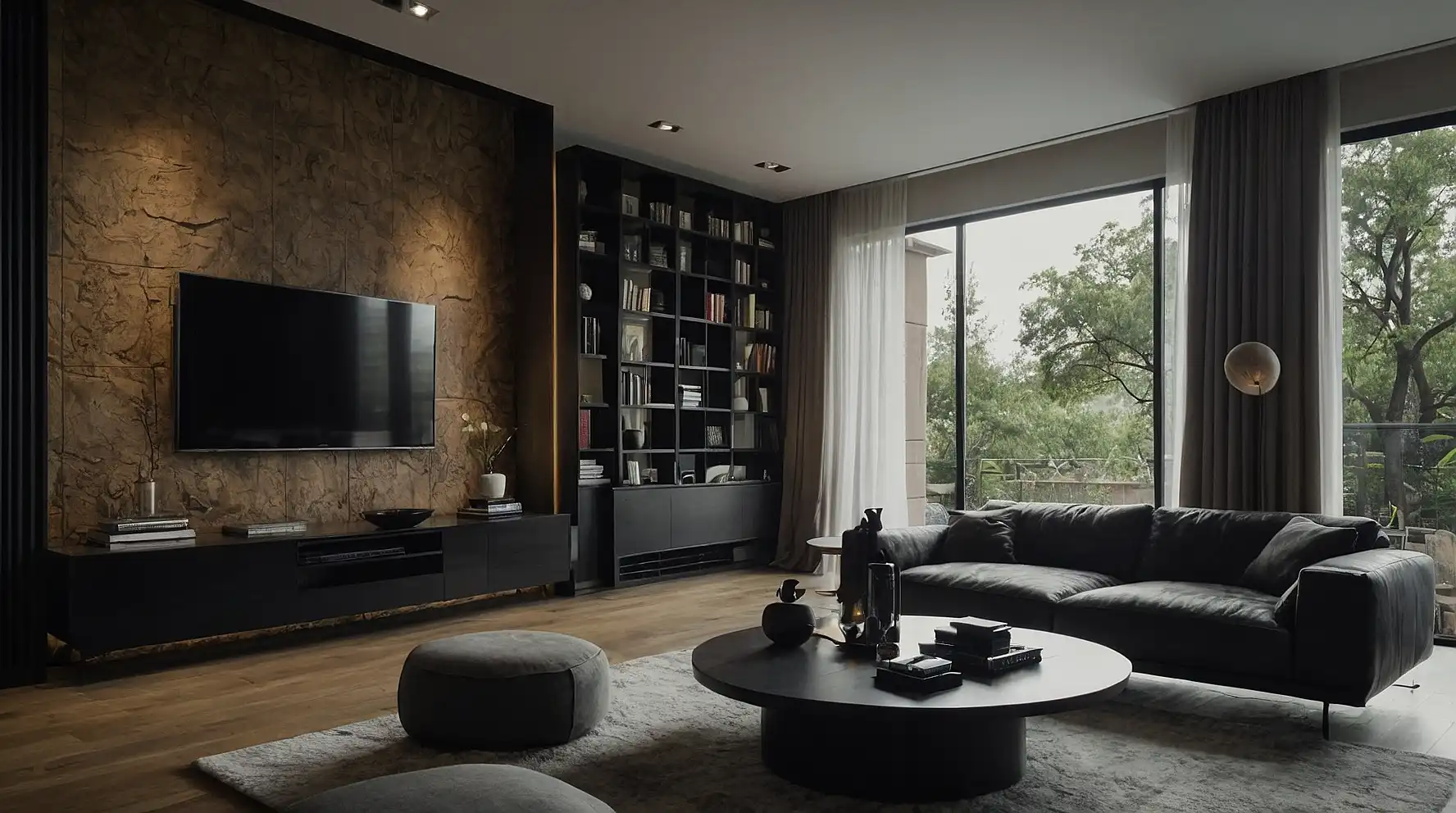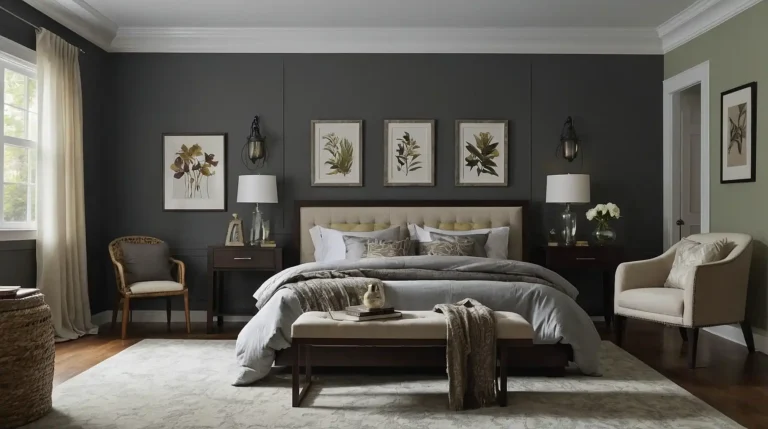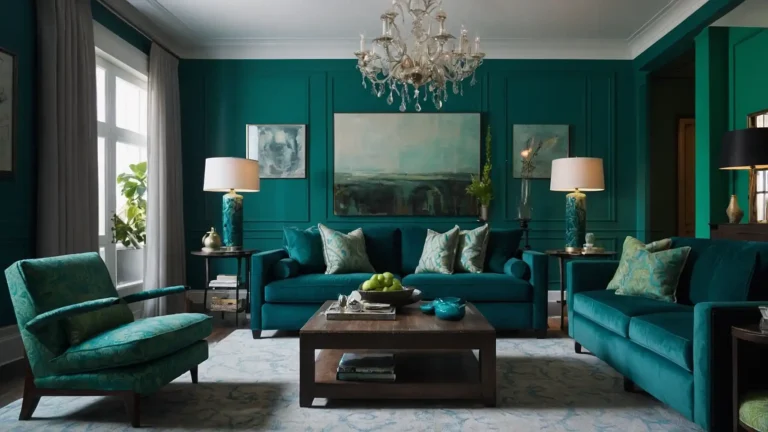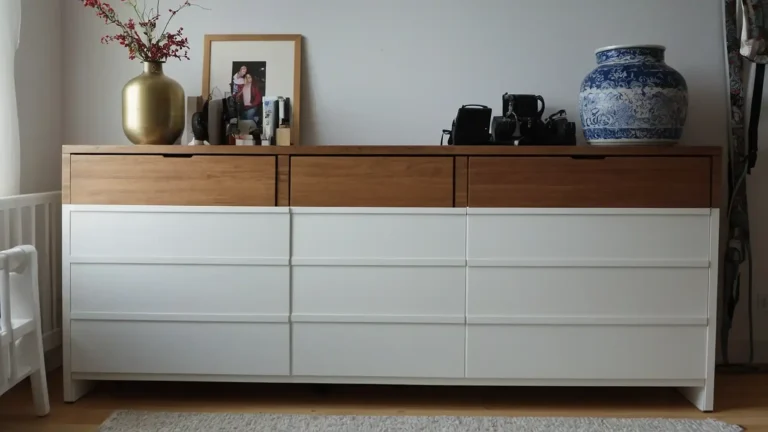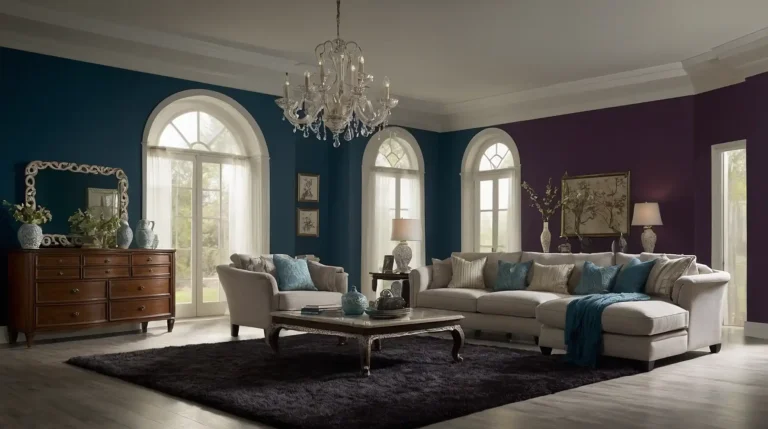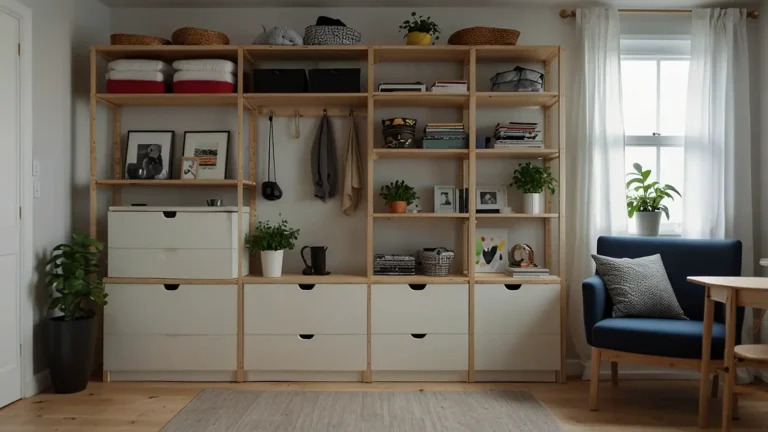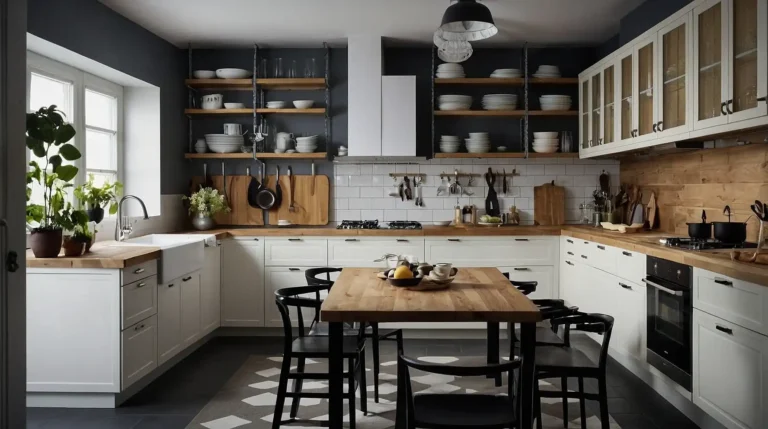27 Small Living Room Ideas
Transform your compact living room into a stylish and functional space with these clever design strategies. Small rooms offer unique opportunities for creative solutions.
You’ll discover how smart furniture choices and visual tricks can make any space feel larger. These ideas prove that size doesn’t limit style or comfort.
From multi-functional pieces to strategic color choices, these concepts work in any small living room. Let’s explore ways to maximize your space beautifully.
1: Light Color Palette
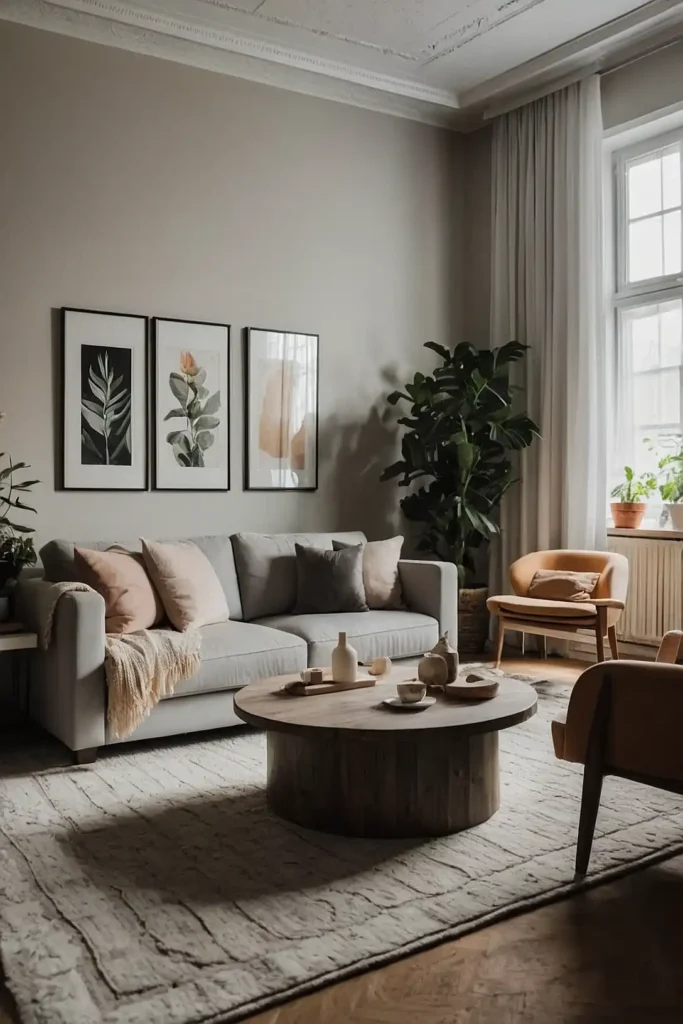
Choose light colors like whites, creams, and soft grays for walls and large furniture pieces. These hues reflect natural light effectively.
Light colors create an airy, open feeling in compact spaces. Avoid dark colors that absorb light and make rooms feel smaller.
Add personality through colorful accessories and throw pillows. This approach keeps the space feeling spacious while adding visual interest.
2: Multi-Functional Ottoman
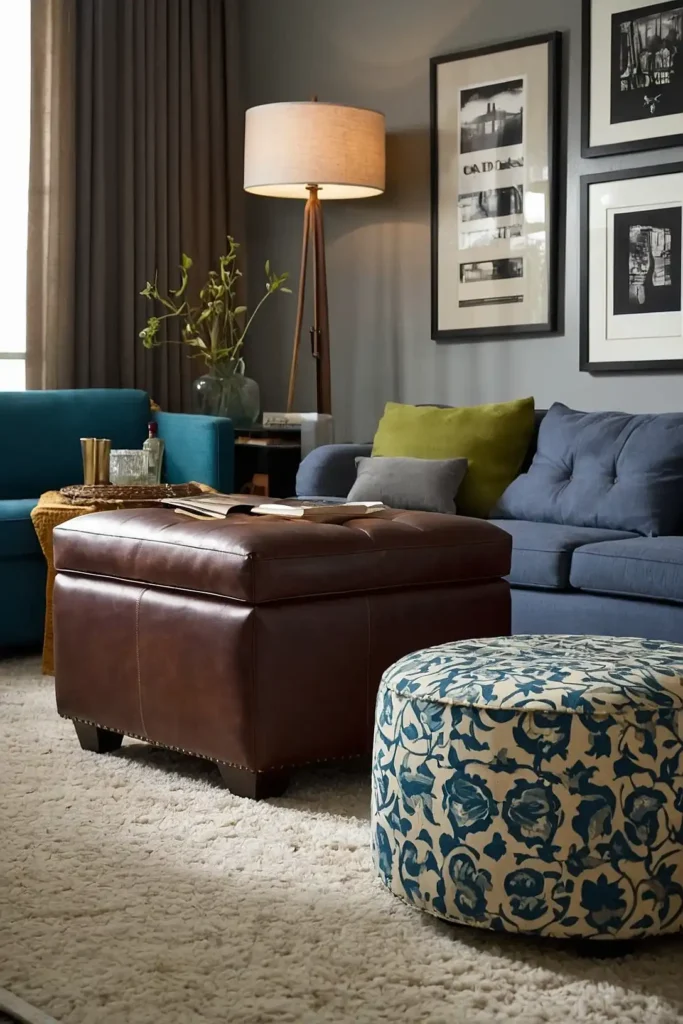
Select an ottoman that serves as seating, storage, and a coffee table. Choose pieces with removable tops for hidden storage.
This eliminates the need for multiple furniture pieces. Store blankets, books, or remote controls inside the ottoman compartment.
Round ottomans work well in small spaces. They provide flexible seating without sharp corners that impede traffic flow.
3: Wall-Mounted Floating Shelves
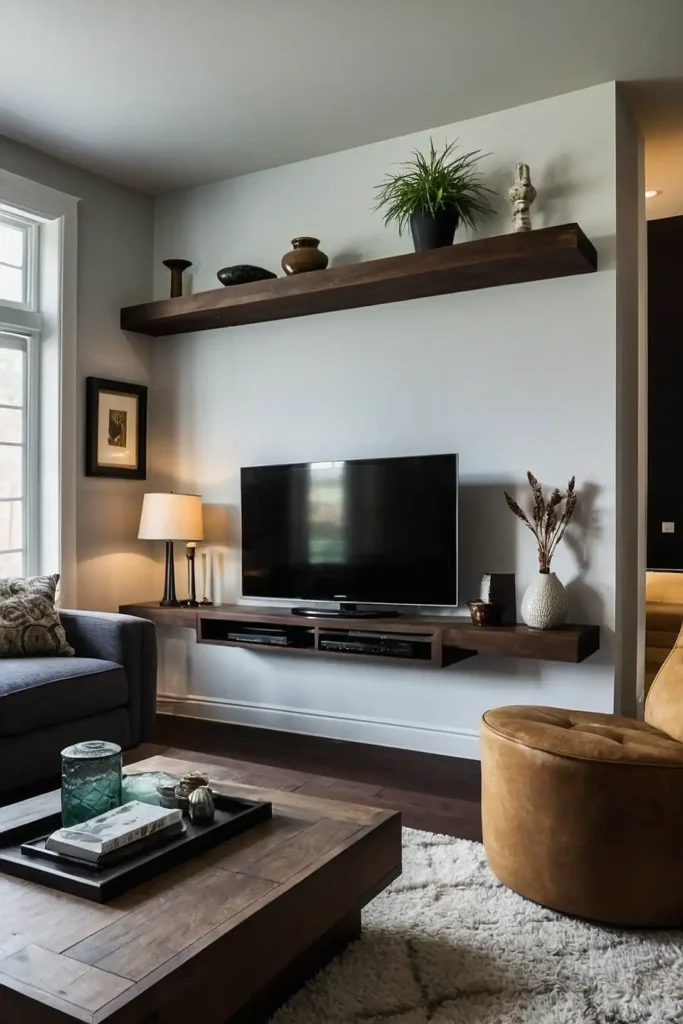
Install floating shelves instead of bulky bookcases or entertainment centers. These create storage without taking floor space.
Arrange shelves at varying heights for visual interest. Display books, plants, and decorative objects to personalize your space.
Choose shelves in colors that match your walls. This creates a seamless look that doesn’t visually fragment the room.
4: Mirrors to Reflect Light
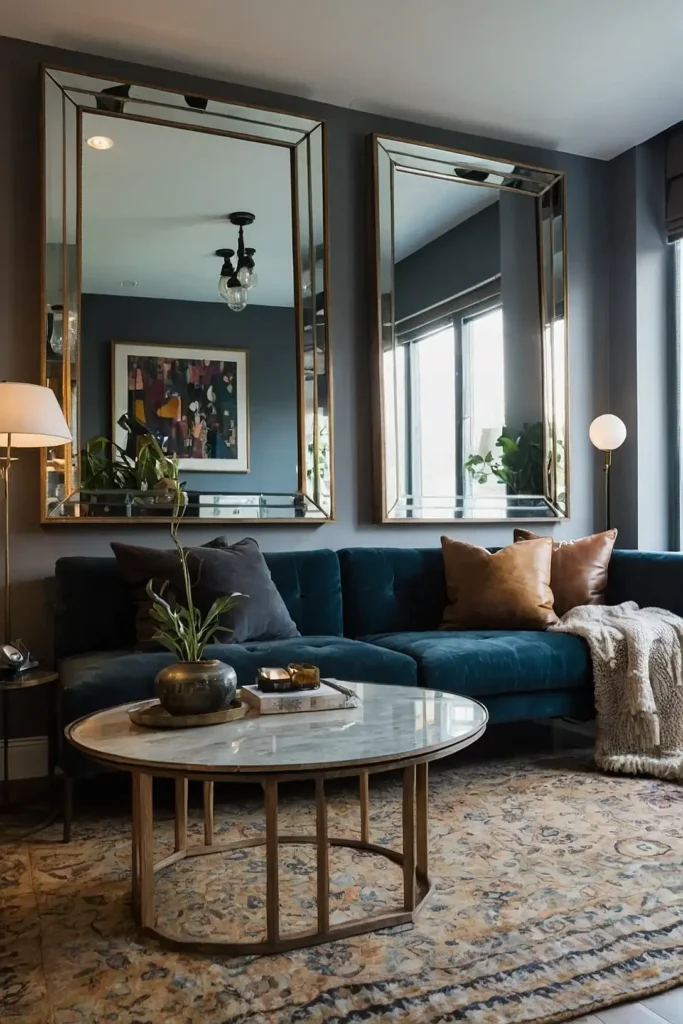
Hang large mirrors opposite windows to double natural light in your room. This creates the illusion of additional space.
Choose mirrors with interesting frames to add decorative appeal. Position them strategically to reflect the most attractive room views.
Multiple smaller mirrors can create gallery wall effects. They add sparkle and dimension while serving the same light-reflecting purpose.
5: Sectional Sofa Configuration
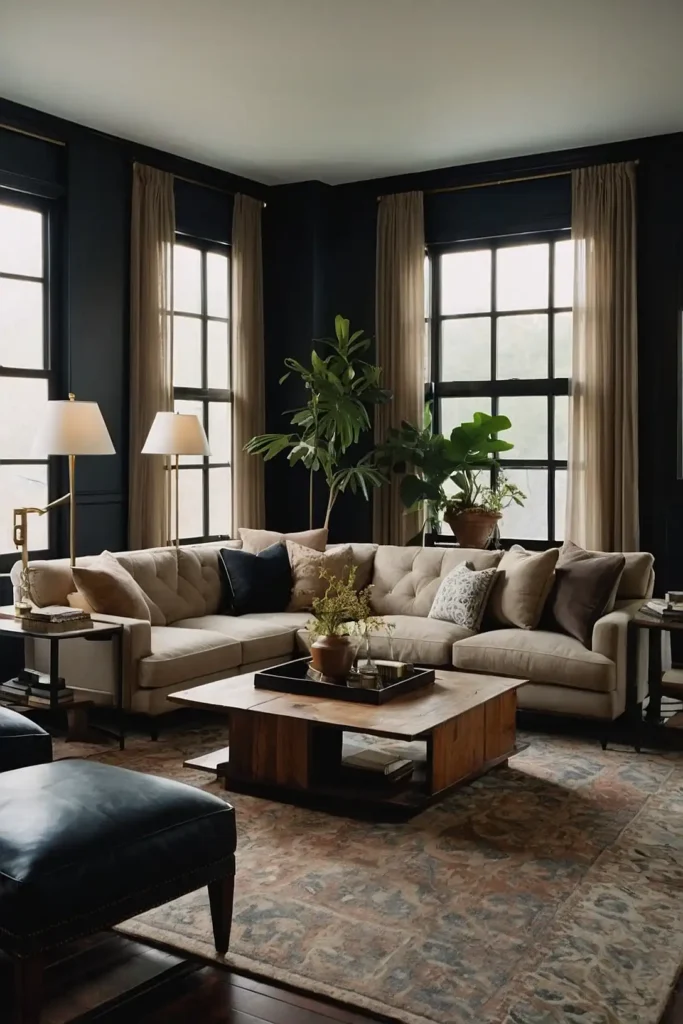
Choose a compact sectional sofa that fits your room’s exact dimensions. L-shaped sections maximize seating in corner spaces.
This provides more seating than separate chairs and sofas. Select pieces with raised legs to create visual flow underneath.
Choose neutral colors for longevity and flexibility. Add colorful throw pillows and blankets for seasonal style changes.
6: Vertical Storage Solutions
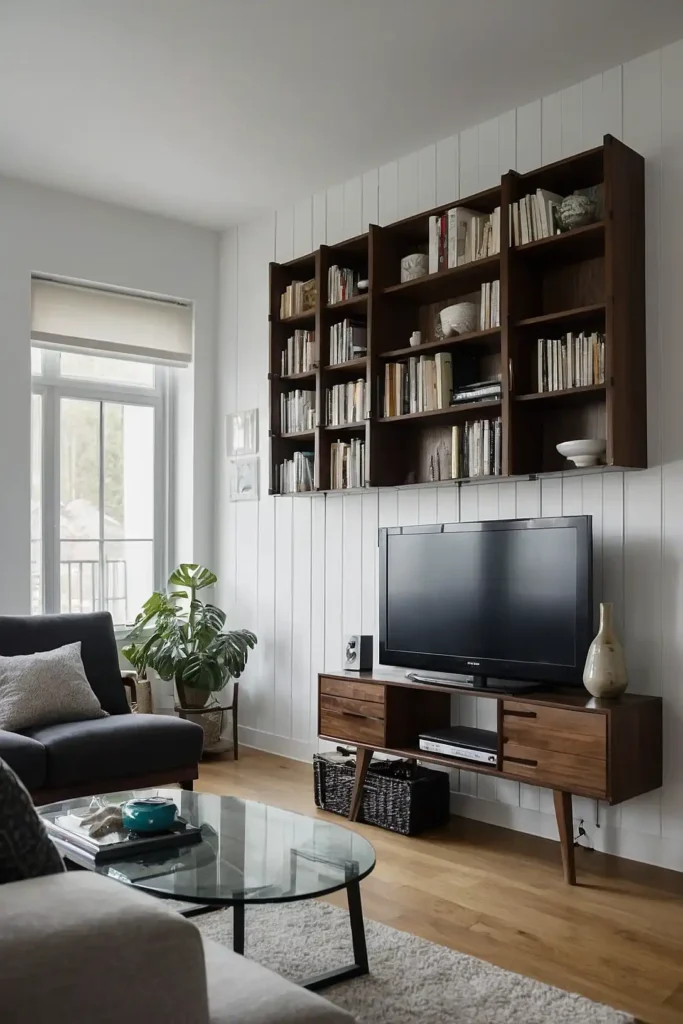
Utilize wall height with tall, narrow storage units. These draw the eye upward and create illusions of higher ceilings.
Choose bookcases or cabinets that reach near the ceiling. This maximizes storage while maintaining minimal floor footprint.
Arrange items with heavier pieces at the bottom. This creates visual stability while keeping frequently used items accessible.
7: Glass Coffee Table
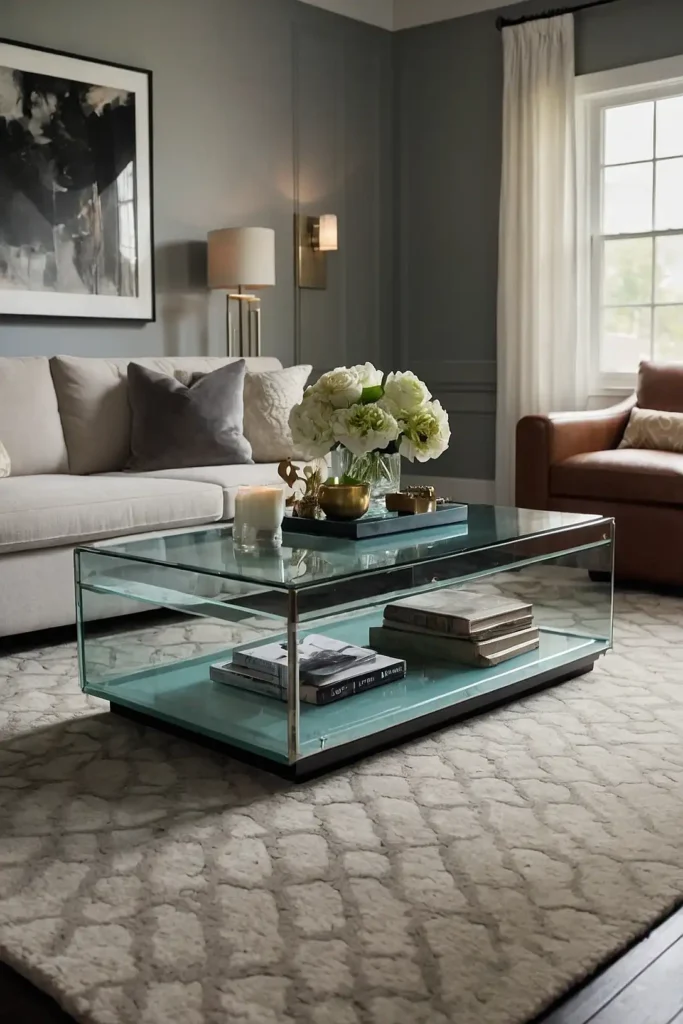
Select a glass or acrylic coffee table to maintain sight lines through your room. Transparent furniture doesn’t visually crowd small spaces.
These tables provide functionality without visual weight. Choose pieces with interesting leg designs for added style.
Glass reflects light and creates sparkle in your room. Clean regularly to maintain the transparent, space-enhancing effect.
8: Built-In Window Seat
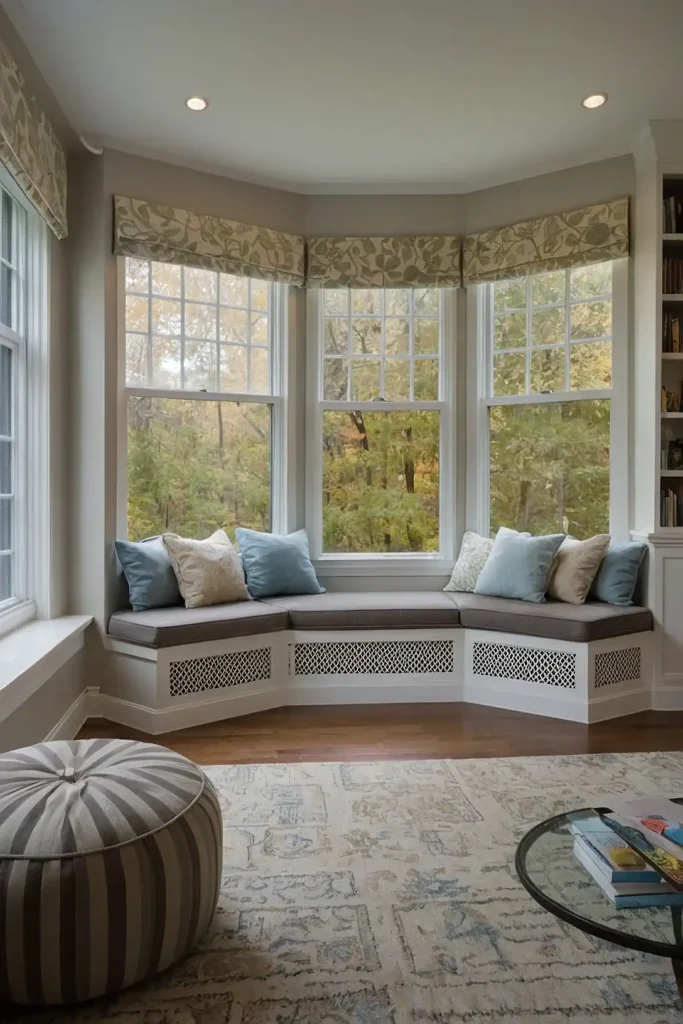
Create a window seat with built-in storage underneath. This maximizes an often-underutilized space while adding seating.
Add cushions and throw pillows for comfort and style. Use the storage for seasonal items or books.
Window seats create cozy reading nooks in small rooms. They provide seating without requiring additional floor space.
9: Fold-Down Desk
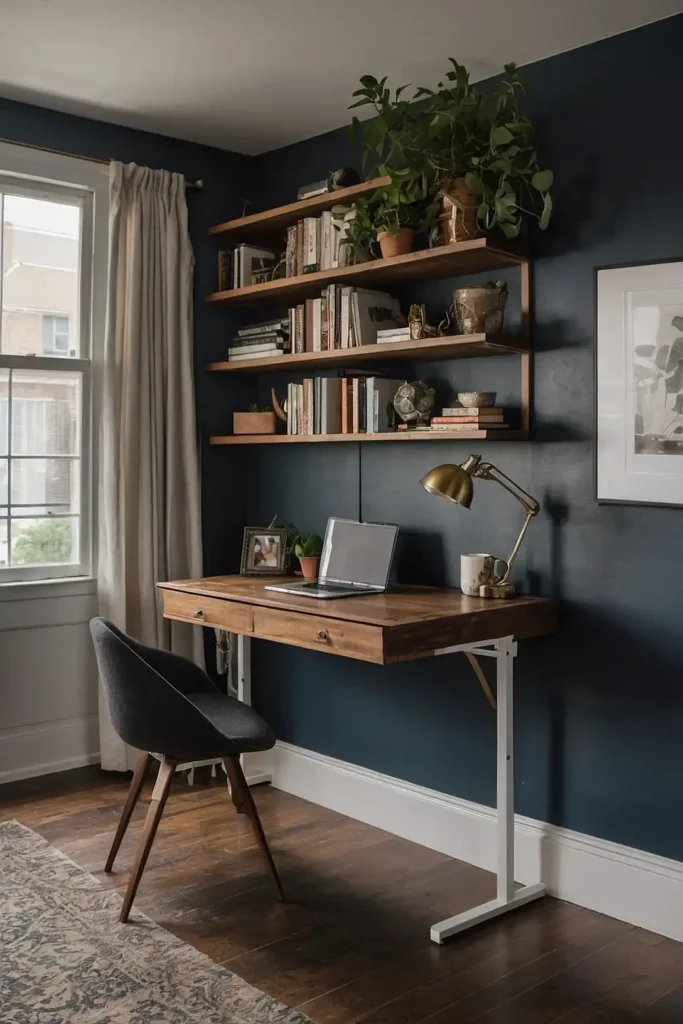
Install a wall-mounted fold-down desk for occasional work or study needs. This provides workspace without permanent furniture commitment.
Choose designs that fold flat against the wall when not needed. This maintains clear floor space for daily living.
Include small shelves above for storage and organization. Select finishes that complement your existing room decor.
10: Strategic Rug Placement
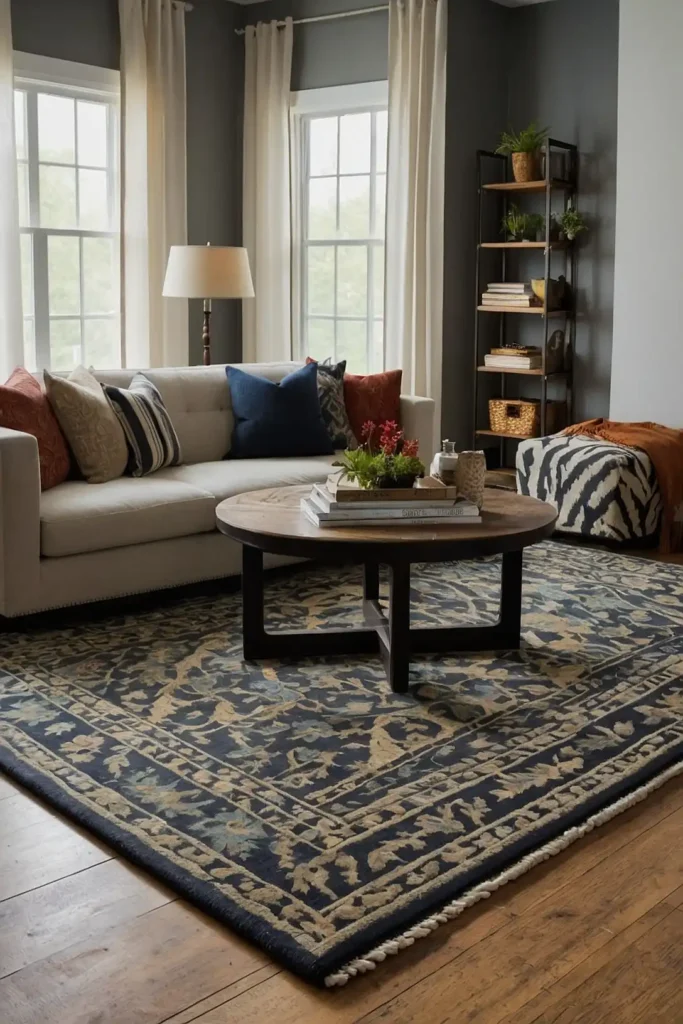
Choose one large area rug rather than multiple small ones. This creates visual unity and makes the room appear larger.
Ensure the rug extends under front furniture legs at minimum. This anchors seating areas and creates cohesive groupings.
Light-colored rugs enhance the spacious feeling. Avoid busy patterns that can make small spaces feel chaotic.
11: Floor-to-Ceiling Curtains
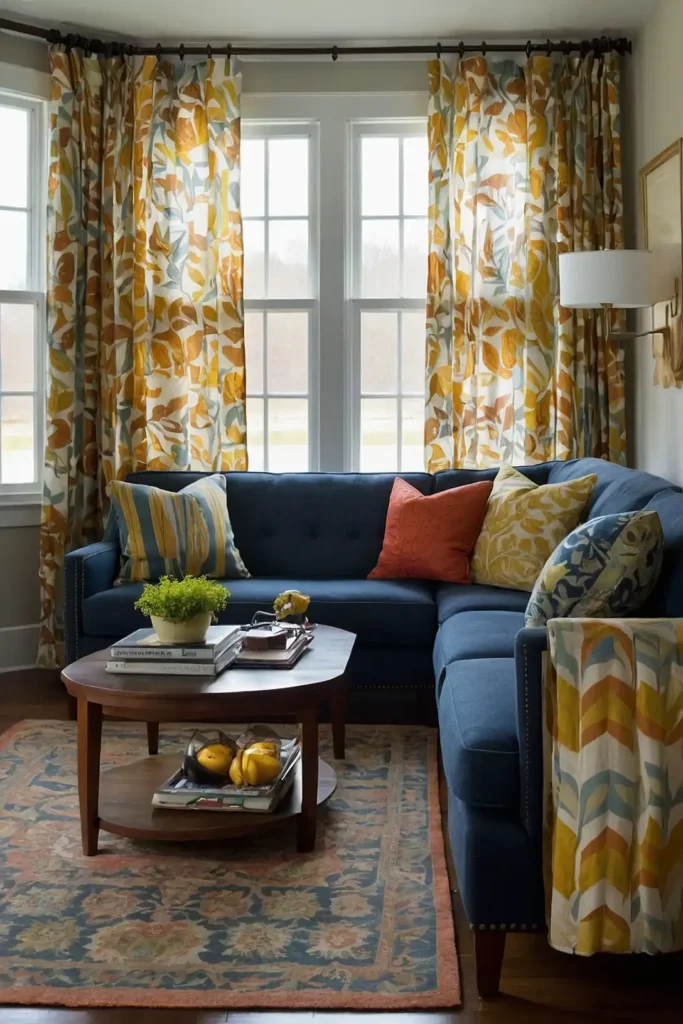
Hang curtains close to the ceiling rather than just above windows. This creates the illusion of taller windows and higher ceilings.
Choose light, flowing fabrics that don’t overwhelm the space. Avoid heavy materials that can make rooms feel smaller.
Select curtains slightly wider than windows for fullness. This technique makes windows appear larger than their actual size.
12: Nesting Tables
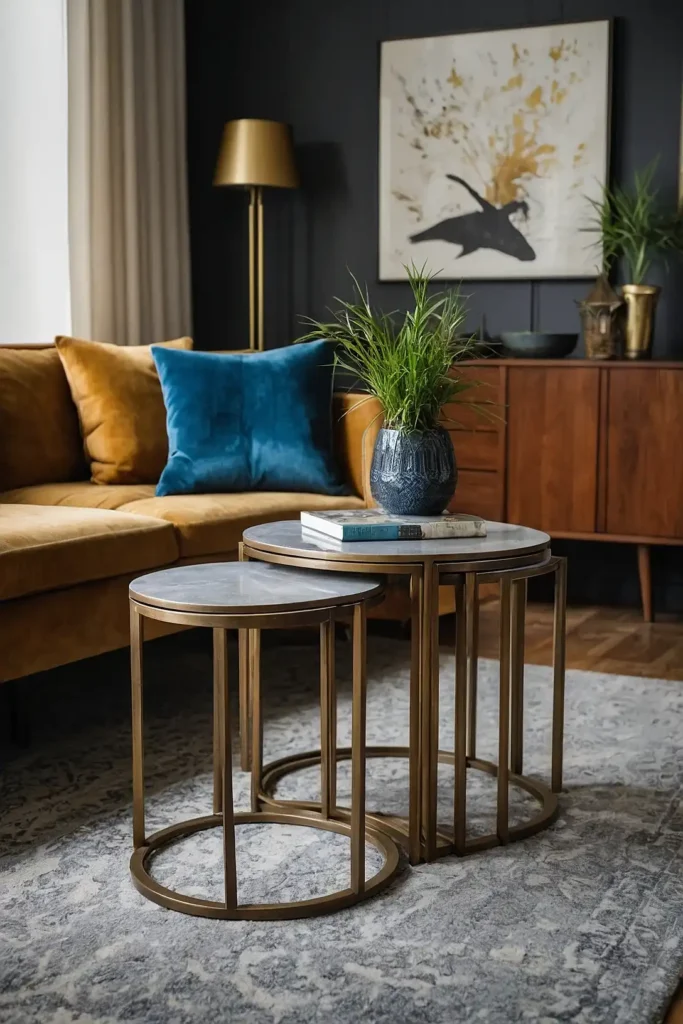
Use nesting tables that tuck together when not needed. These provide surface space for entertaining while saving storage room.
Pull out additional tables only when hosting guests. This maintains clear pathways during everyday use.
Choose designs that complement your main coffee table. Different heights create visual interest when arranged together.
13: Wall-Mounted TV
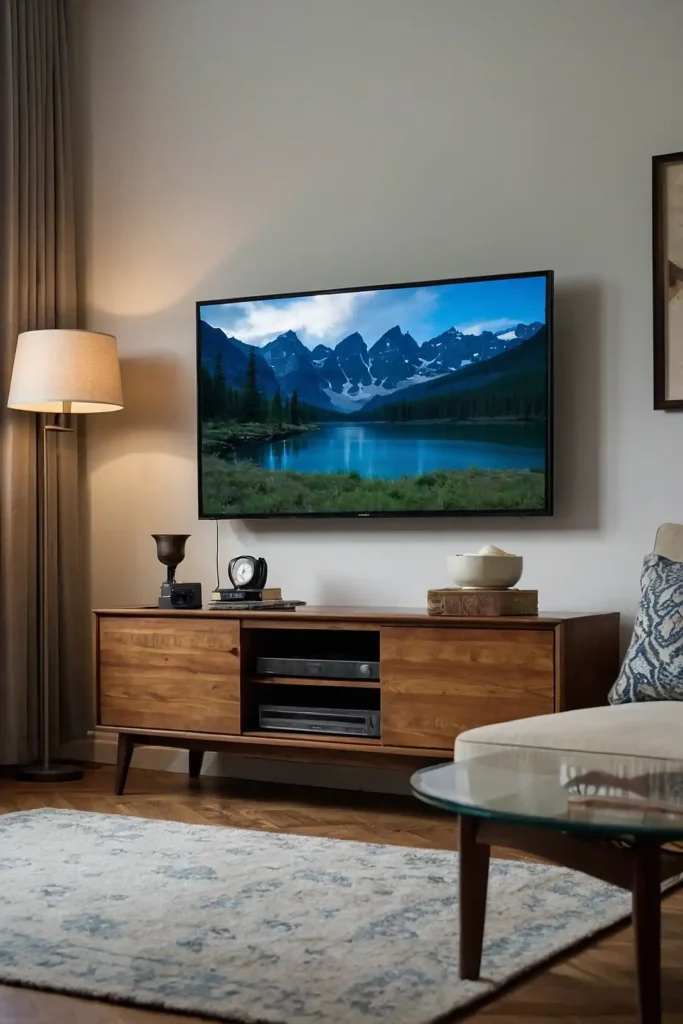
Mount your television on the wall to free up floor space. This eliminates the need for entertainment centers or TV stands.
Hide cables with cord management systems for clean appearances. Position the TV at comfortable viewing height from seating.
Create a gallery wall around the mounted TV. This makes the television feel like part of your room’s design.
14: Compact Dining Solution
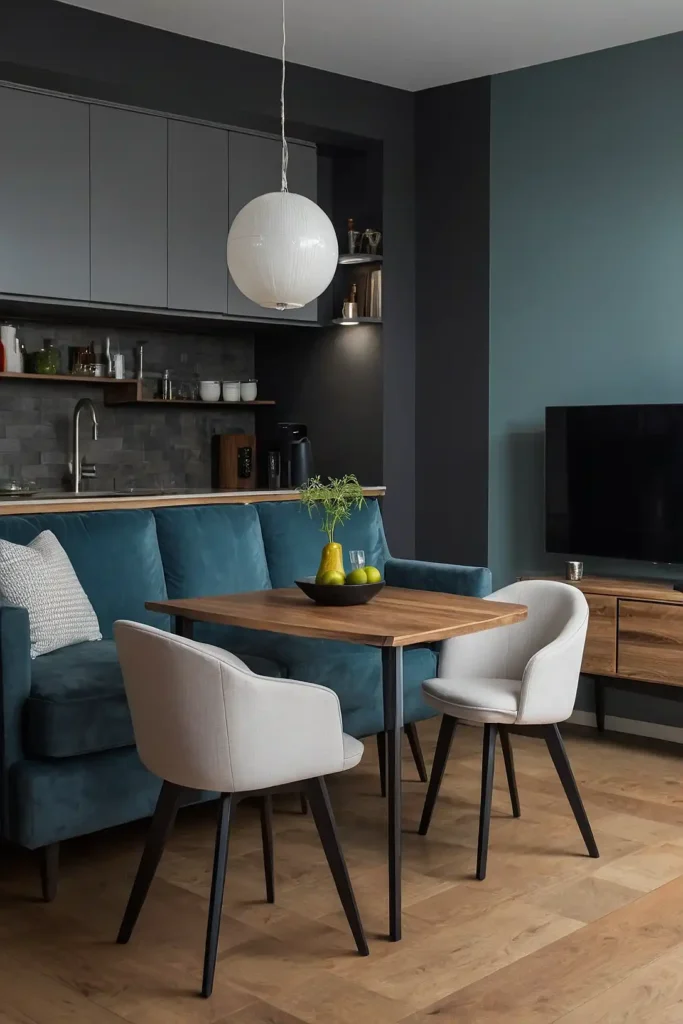
Choose a small round table for dining that doubles as workspace. Round tables facilitate better conversation and traffic flow.
Select chairs that tuck completely under the table. This maintains clear pathways when the table isn’t in use.
Consider extendable tables for occasional larger gatherings. These adapt to your space needs while maintaining compact everyday footprints.
15: Corner Furniture Placement
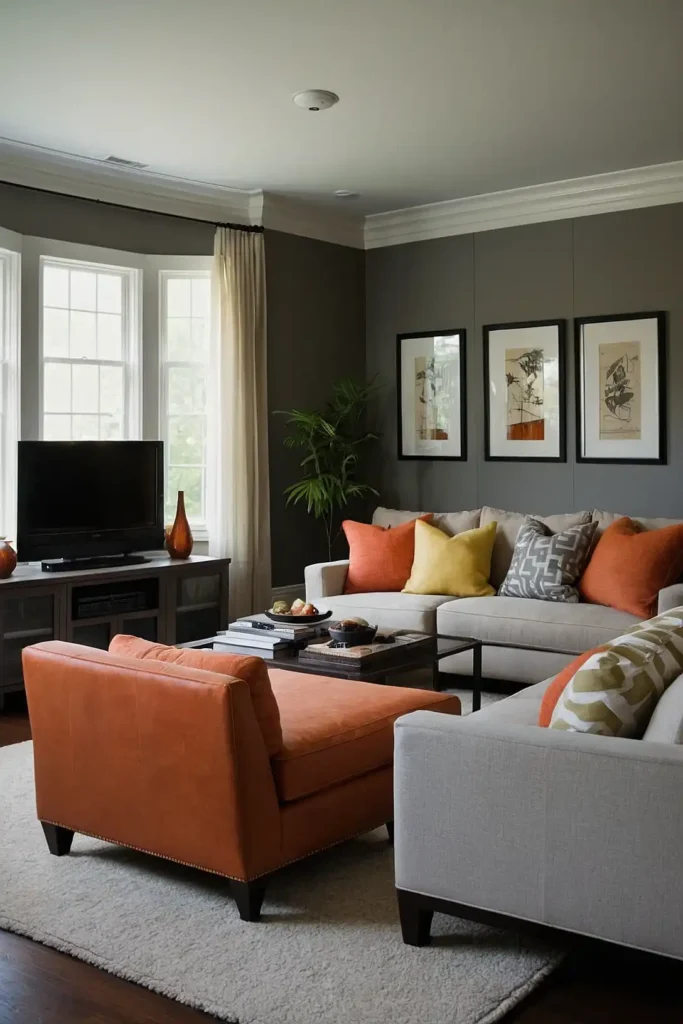
Utilize corner spaces with specifically designed corner furniture pieces. These make use of otherwise wasted space effectively.
Corner shelving units provide storage without protruding into room pathways. Choose pieces that fit your exact corner dimensions.
Angled furniture placement can create more interesting room layouts. This approach often improves traffic flow in small spaces.
16: Dual-Purpose Storage Bench
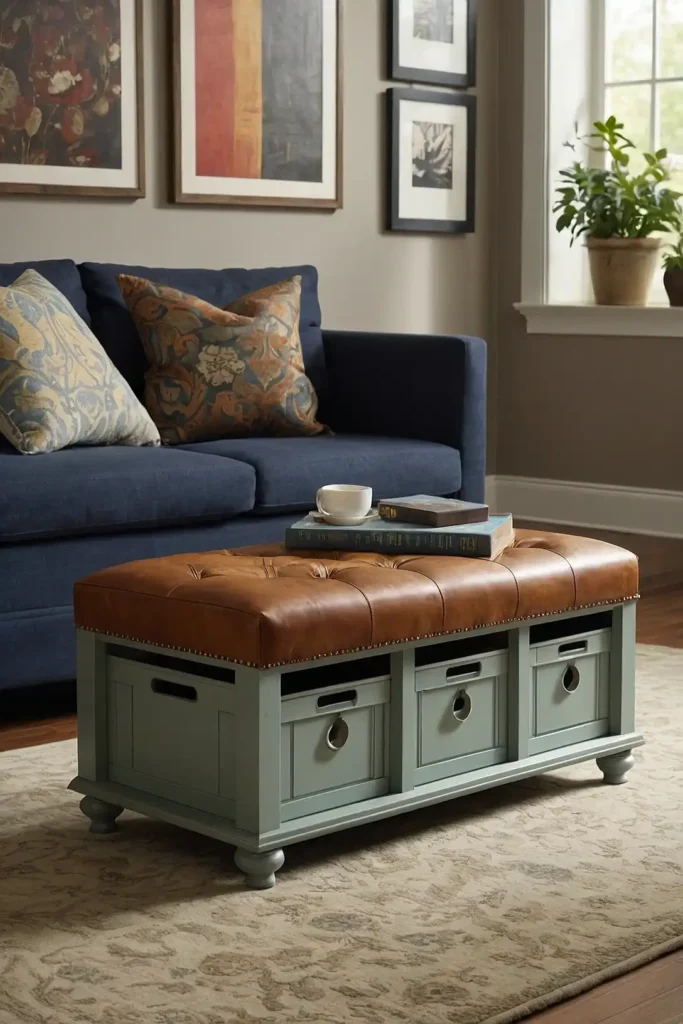
Place a storage bench along walls for seating and hidden storage. These pieces serve multiple functions efficiently.
Store items like extra linens, games, or seasonal decorations inside. Add cushions for comfortable additional seating options.
Choose benches that match your existing furniture styles. This creates cohesive design while adding functional elements.
17: Open Floor Plan Feeling
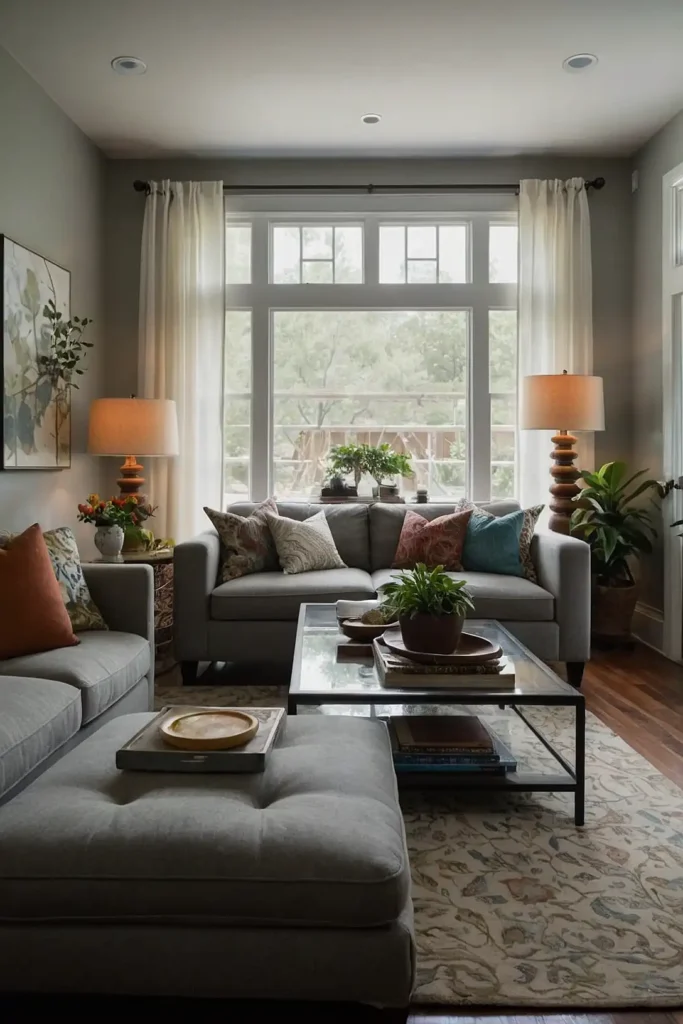
Remove unnecessary walls or partitions where possible to create open sight lines. This makes small spaces feel significantly larger.
Use furniture placement to define different zones within the space. Area rugs help delineate living areas from other functions.
Maintain consistent flooring throughout to enhance the open feeling. Different floor materials can visually chop up small spaces.
18: Minimalist Decor Approach
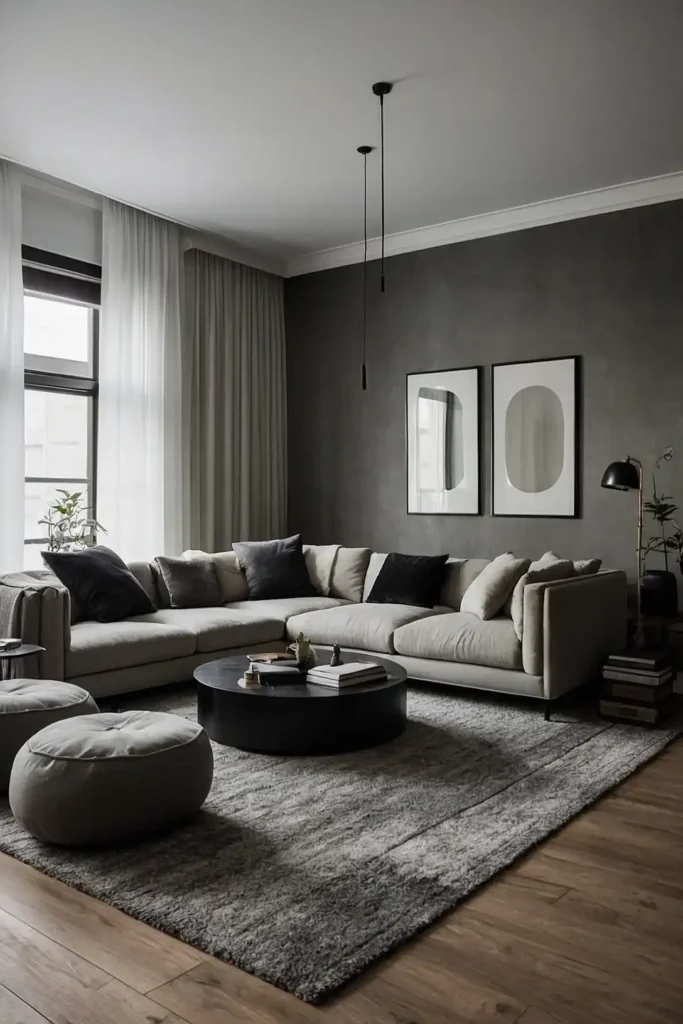
Adopt a “less is more” philosophy when decorating small living rooms. Choose fewer, higher-quality decorative pieces.
This prevents visual clutter that makes spaces feel cramped. Select items that serve both decorative and functional purposes.
Group similar items together rather than scattering them throughout. This creates focal points while maintaining clean sight lines.
19: Lighting Layer Strategy
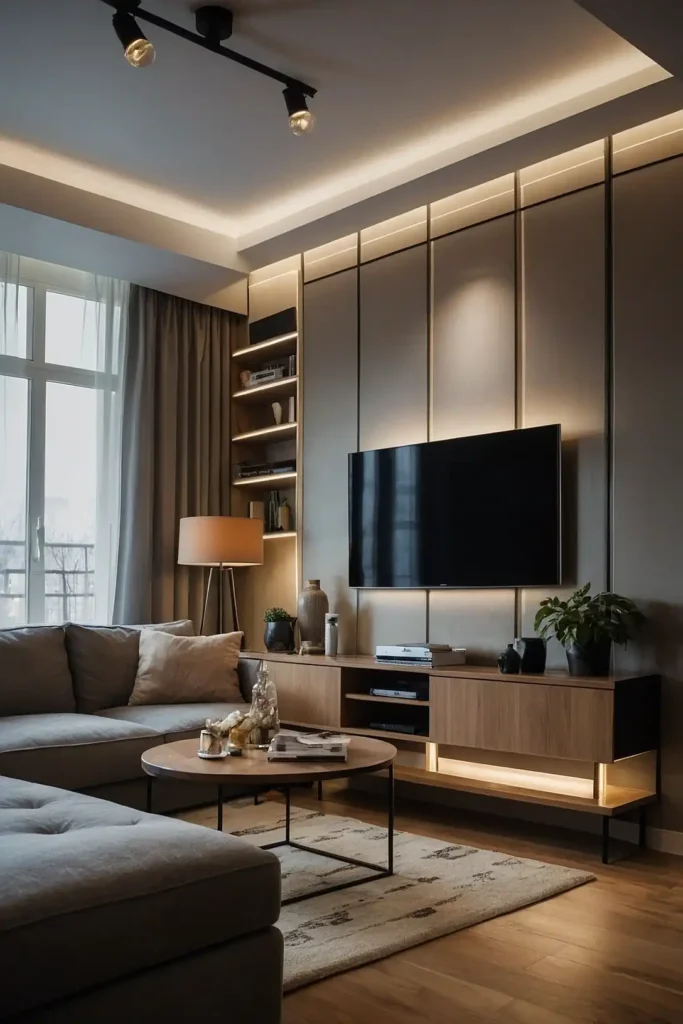
Combine ambient, task, and accent lighting to create depth and interest. Multiple light sources make rooms feel larger and more inviting.
Use table lamps, floor lamps, and overhead lighting together. This eliminates dark corners that can make spaces feel smaller.
Choose warm white bulbs for cozy atmospheres. Good lighting makes any space feel more spacious and welcoming.
20: Sliding Door Storage
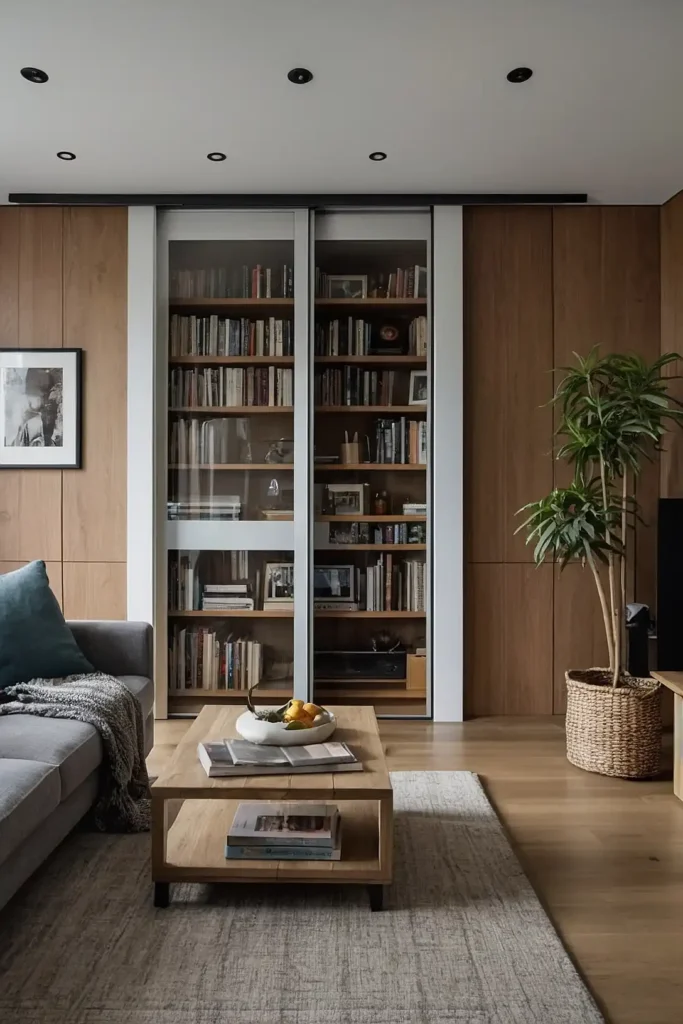
Install sliding door storage units that don’t require swing space. These work well in tight areas near seating.
Choose doors that slide behind furniture or into wall pockets. This maintains access while preserving precious floor space.
Use sliding doors for media storage or closets. They provide full access without the space requirements of hinged doors.
21: Tall Plants for Vertical Interest
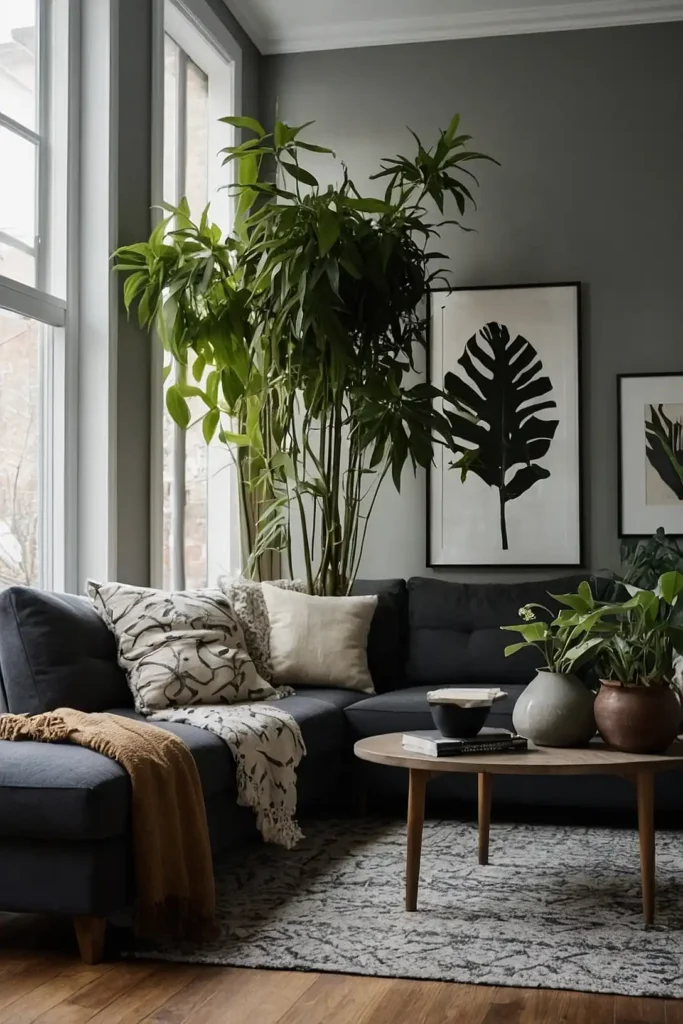
Add tall plants in corners to draw the eye upward. This creates the illusion of higher ceilings in compact rooms.
Choose plants like fiddle leaf figs or snake plants. These require minimal floor space while providing maximum visual impact.
Use decorative planters that complement your room’s style. Plants add life and color without taking significant space.
22: Modular Furniture Systems
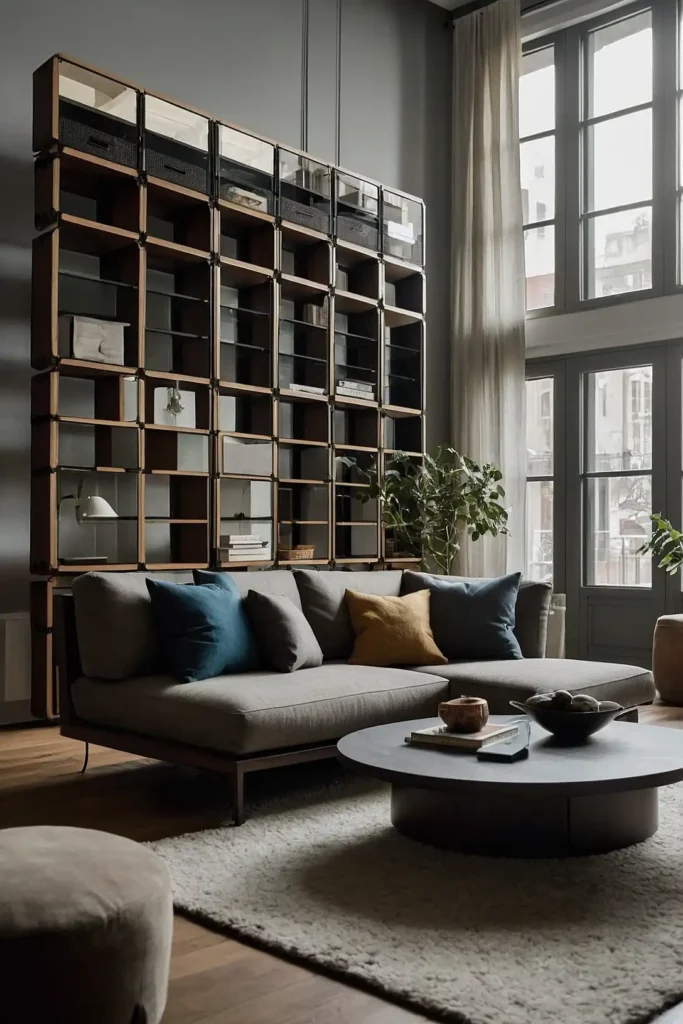
Choose modular furniture that adapts to changing needs and room configurations. These pieces offer maximum flexibility.
Rearrange modules for different occasions or seasons. This keeps your living room feeling fresh and functional.
Start with basic modules and add pieces over time. This approach spreads costs while building a complete furniture system.
23: Under-Stair Storage
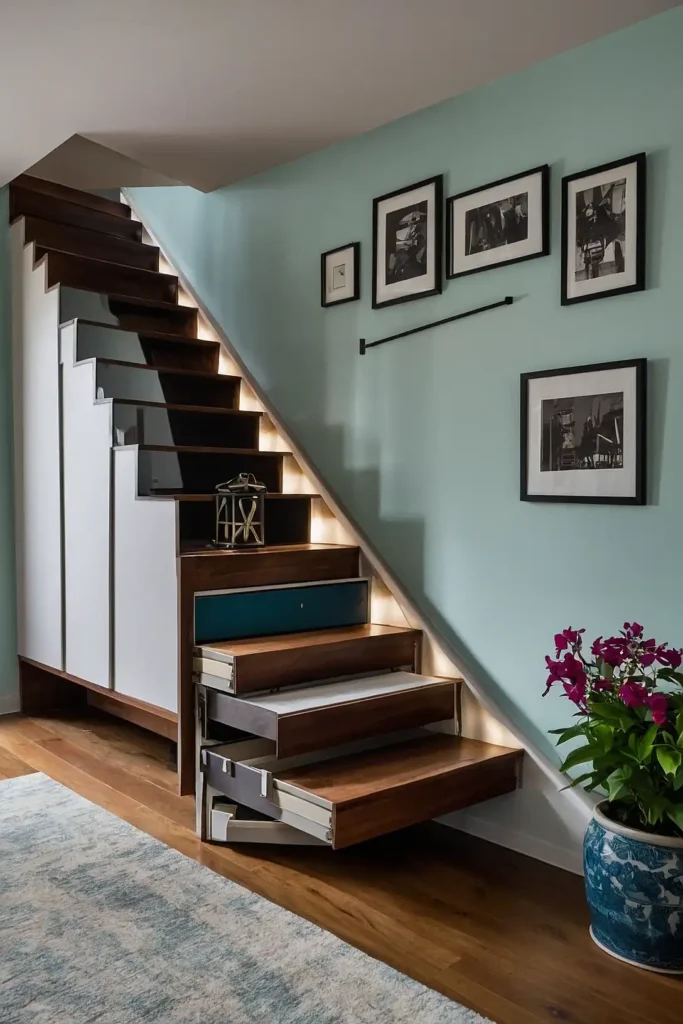
Utilize space under staircases for storage or seating areas. These often-wasted spaces provide valuable square footage.
Install built-in shelving or create cozy reading nooks. This maximizes every available inch in your living area.
Choose furniture that fits the slanted ceiling lines. Custom pieces often work best in these unique spaces.
24: Artwork Gallery Wall
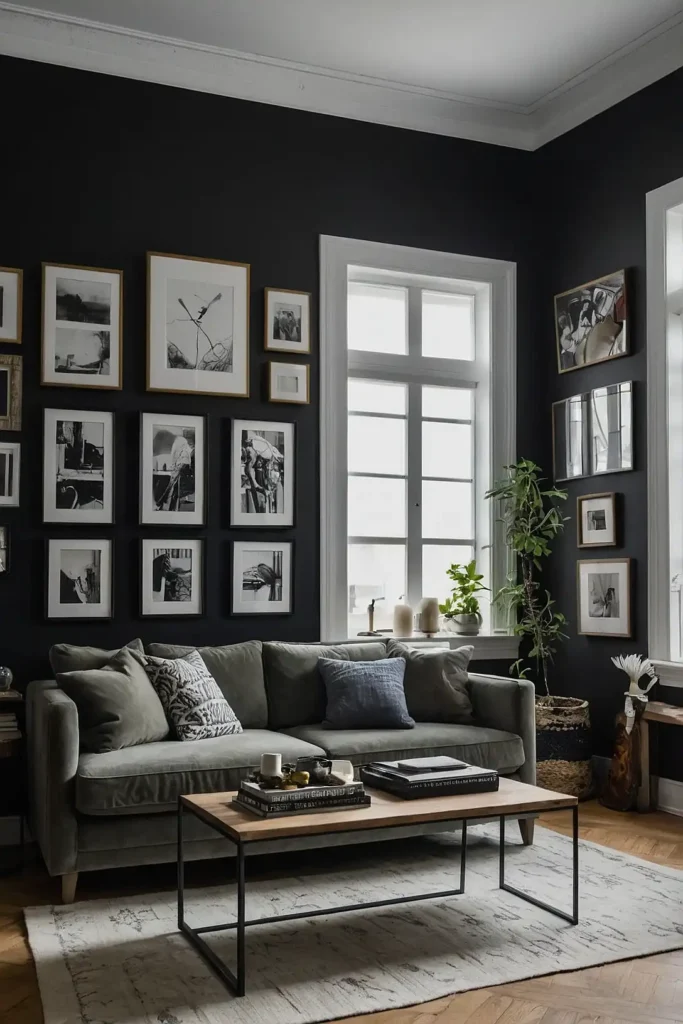
Create a gallery wall with multiple smaller pieces rather than one large artwork. This adds personality without overwhelming spaces.
Arrange pieces before hanging to perfect the layout. Mix different frame sizes and artwork types for visual interest.
Keep consistent spacing between pieces for professional appearances. Gallery walls draw attention upward, enhancing ceiling height illusions.
25: Neutral Base with Colorful Accents
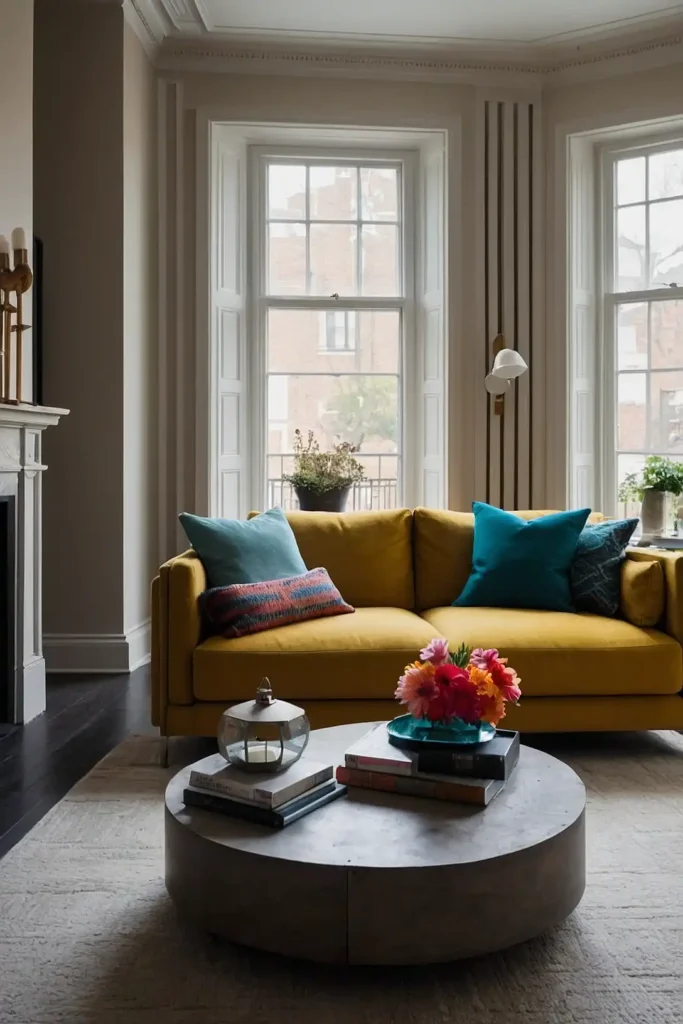
Use neutral colors for major furniture pieces and add personality through colorful accessories. This approach offers flexibility.
Change throw pillows, artwork, and accessories seasonally. This refreshes your room without replacing expensive furniture pieces.
Neutral bases make small spaces feel larger and brighter. Colorful accents prevent rooms from feeling bland or boring.
26: Multi-Level Lighting Design
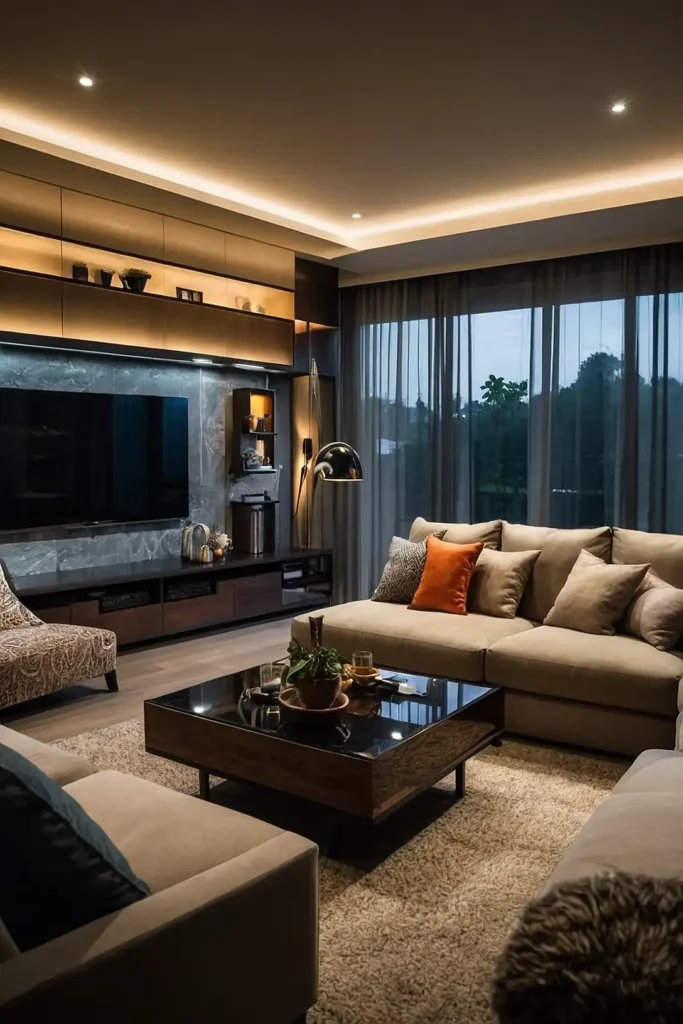
Install lighting at different heights throughout your room. This creates visual layers that add depth to small spaces.
Combine overhead fixtures, table lamps, and floor lamps strategically. Vary light heights to create interesting shadows and highlights.
Use pendant lights or sconces to save table space. These provide necessary lighting without requiring surface area.
27: Flexible Seating Options
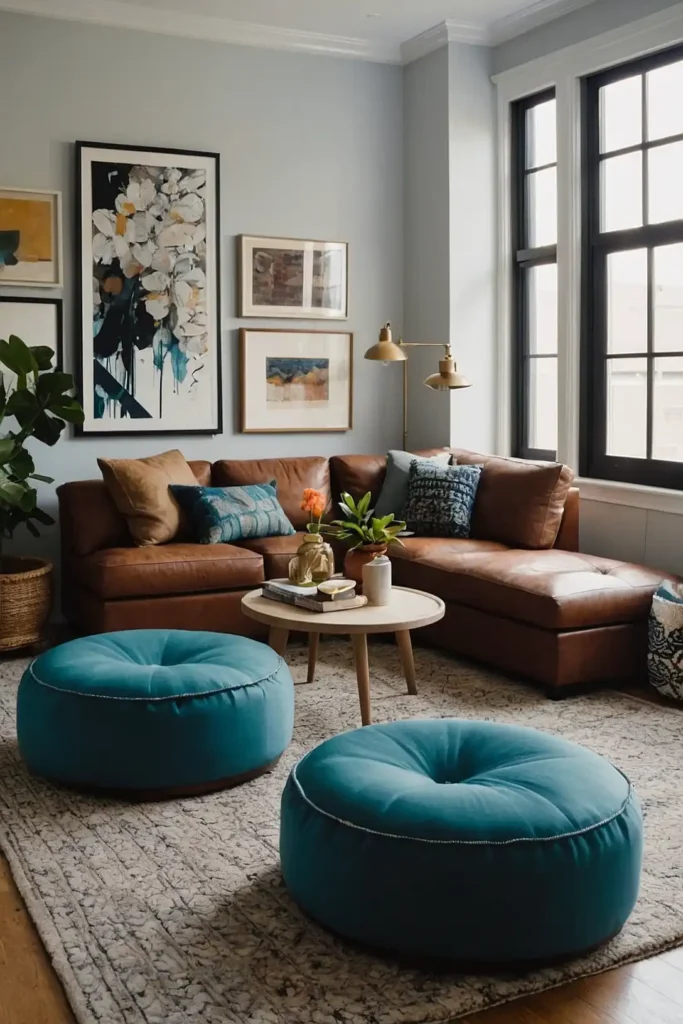
Include seating that moves easily throughout your room. Poufs, stools, and lightweight chairs adapt to different needs.
Store extra seating when not needed to maintain clear pathways. Bring out additional pieces only when entertaining guests.
Choose seating that serves multiple purposes whenever possible. This maximizes functionality while minimizing required furniture pieces.
Conclusion
These small living room ideas prove that compact spaces can be both stylish and highly functional with smart design choices.

